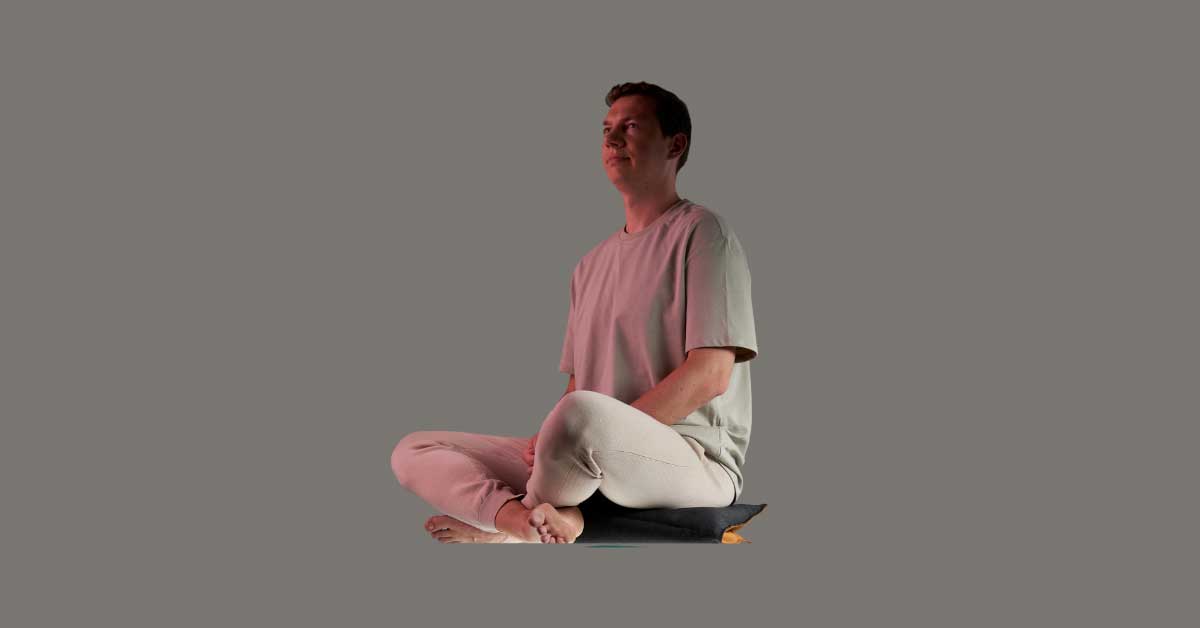Imagine improving your health, cognition, and well-being in just a few minutes and in a quiet place. Sounds too good to be true, right? But it is not. In summary, this is what several reputable scientific studies have shown.
It can change your brain and body in quite amazing ways, such as lowering stress, enhancing mood, boosting cognitive functions, and improving immunity.
But how does meditation actually work and affect our body and brain? Let us investigate further.
The science of meditation
The first reported evidence of meditation comes from ancient northern India and southern China. Similarly, the first written records of meditation originated around 1500 BCE in Central Asia. The Vedic texts introduced the term ‘Dhyana,’ which explains meditation practices.
As meditation spread, it influenced different cultures and traditions, including Judaism, Hinduism, Jainism, Sikhism, and Buddhism.
Meditation gained popularity in the late 19th and early 20th centuries when researchers began to identify the potential benefits of meditation on both mind and body.
In the 21st century, meditation is being practiced with diverse techniques and approaches around the globe.
We all know it is genuinely hard for the regular person to distinguish good from bad science.
So we have done our best in this article to cite and draw insights only from reputable sources like the UC Davis Department of Neurological Surgery, Laboratory of Cognitive Affective Neuroscience, The University of Hong Kong, NeuroReport, Srinakharinwirot University, Thailand, and Yale School of Medicine.
Let us look at the most interesting findings.
Changes in the brain waves
Brain waves are the electrical patterns that occur in our brain depending on the state of mind. During meditation, there is an increase in alpha and theta brain frequencies associated with a relaxed and calm state of mind.
Lee et al. (2018) conducted a study in the UC Davis Department of Neurological Surgery. The study explored the effects of four types of meditation on the brain waves:
- Focused attention meditation,
- Open-monitoring meditation,
- Transcendental meditation,
- Loving-kindness meditation.
The researchers used electroencephalography(EEG) to measure the brain waves of 59 participants, aged 20 to 69, who were either experienced meditators or beginners.
The results showed that focused attention, open-monitoring, transcendental, and loving-kindness meditation increased the power and diversity of brain waves in the meditators. The longer they meditated, the more changes they observed. Focused attention meditation and open-monitoring meditation increased the theta waves in the front part of the brain, but only focused attention meditation increased them in the back part.
Both focused attention meditation and open-monitoring meditation increased the alpha waves in the back part, but they had different effects in the front part. Focused attention meditation increased them on both sides, while open-monitoring meditation decreased them on the left side. The very fast gamma waves also change in different ways depending on the type of meditation and the location in the brain.
The authors concluded that each type of meditation has a unique impact on the brain waves. They also suggested that these changes could benefit cognitive function and well-being.

Decrease in amygdala activity
Amygdala is a part of the brain that is responsible for processing emotions such as sadness, anxiety, fear, and other negative emotions. Meditation reduces this activity in the brain, leading to decreased feelings of stress and anxiety.
Mei Kei Leung et al. (2017) conducted a study in the Laboratory of Cognitive Affective Neuroscience, The University of Hong Kong. The study examined the effects of awareness-based compassion meditation (ABCM) on the amygdala, a brain region that is involved in emotional processing and regulation.
The researchers used functional magnetic resonance imaging (fMRI) to measure the brain activity of 59 participants, aged 25 to 71, who were assigned to either an ABCM group or a relaxation group. Both groups practiced daily for eight weeks, but the ABCM group followed a meditation protocol while the relaxation group listened to relaxing music.
After the intervention, the participants were shown affective and neutral stimuli in a non-meditative state, and their amygdala activity was recorded.
According to the findings, the group that received ABCM training had less anxiety and lower activity in the right amygdala when they faced negative emotions compared to the group that did relaxation exercises.
Furthermore, the more compassion practice the ABCM participants did, the more they reduced their right amygdala activity when they encountered negative emotions.
The authors proposed that ABCM training may help people cope with negative emotions by decreasing the activity of the right amygdala and that these benefits may extend to their everyday lives.
Increase in prefrontal cortex activity
Regular meditation strengthens the prefrontal cortex, which is responsible for various cognitive functions such as emotional regulation, decision-making, and memory.
Lazar et al. (2005) conducted a study to investigate the impact of meditation on the thickness of the cerebral cortex associated with attention, interoception, and sensory processes.
The research involved 20 meditation practitioners with 9.1 ± 7.1 years of meditation experience and 15 control participants without prior meditation experience. Using magnetic resonance imaging (MRI), the researchers measured the cortical thickness of both groups.
The results showed that meditation practitioners had increased cortex thickness in brain regions related to attention, interoception, and sensory processing compared to the control group. The differences in cortical thickness were not explained by age or sex, indicating a specific effect of meditation practice.
The cortical thickness of certain regions correlated positively with the amount of meditation experience, suggesting a dose-dependent relationship between practice and structural changes in the brain.
Reduction in the stress hormone cortisol
Cortisol hormone is released in response to stress and exerts negative effects on the body, including increased inflammation, reduced immune function, and increased blood sugar levels. Regular meditation has been found to decrease the cortisol level in the body.
Turakitwanakan W; Mekseepralard C; Busarakumtragul P (2013) conducted research at Srinakharinwirot University, Thailand, on 30 second-year medical students (aged 18-20) to evaluate the impact of mindfulness meditation on stress levels.
This four-day mindfulness meditation program measured the cortisol level in the blood. The results concluded that mindfulness meditation reduces stress by lowering cortisol levels.
By reducing the amount of cortisol, a stress hormone, in the blood, mindfulness meditation can also help lower the risk of getting diseases that are caused by stress, such as psychiatric disorders, peptic ulcers, and migraine. Therefore, mindfulness meditation should be combined with standard treatment for better health outcomes.
Decrease activity in the default mode network
The default mode network (DMN) is a part of the brain that is activated when the mind is at rest. However, increased activity in this region is associated with negative feelings and thoughts.
Kathleen et al. (2015) performed a study at Yale School of Medicine to compare meditation with an active cognitive task to determine if meditation leads to reduced DMN activity. This study included 20 experienced meditators and 26 non-meditators (control group).
After performing an active cognitive task, the participants were randomly instructed to engage in three mindful meditation practices, including concentration, loving-kindness, and choiceless awareness. The brain activity of participants was observed through an MRI scan.
The MRI showed that the meditator group had a significant reduction in the activity of DMN as compared to the control group. The results concluded that meditation leads to improved attention, memory, and overall health outcomes.
Are there any potential side effects of meditation?
Meditation is considered a safer practice that has multiple health benefits. However, in rare cases, some individuals may experience temporary undesirable effects, including mental overactivity, emotional release, dissociation, physical discomfort, or fatigue.
Feeling sad or exhausted after practice is normal because meditation brings up suppressed emotions to start the healing process and create self-awareness. You can cope easily with these mental effects by observing your thoughts, relaxing your body, accepting your emotions, and grounding yourself.
Practice meditation regularly and consistently. The more you meditate, the more you will get used to it, and the less likely you will experience negative effects.
Physical discomfort and fatigue are primarily related to an improper sitting posture. To avoid or relieve this, you can use a comfortable and supportive cushion or bench for your meditation practice.
A good cushion can help you maintain a proper posture and alignment for your spine and hips, which can improve your breathing and blood flow and thus reduce muscle tension and fatigue.
If you are looking for a premium meditation cushion that can enhance your practice and well-being, try SUMA’s meditation cushions.
SUMA’s cushions are made from natural materials that are eco-friendly and durable. They are designed to fit different body types and preferences. They come in various shapes, sizes, colors, and patterns that can suit your style and personality. You can check them out here.
Takeaway
Meditation has scientifically proven benefits for both mental and physical health. Regular meditation leads to structural changes in the brain, reduces stress hormones, and increases activity in certain brain regions. These positive changes contribute to emotional well-being and help in attaining calmness. Try to set aside 5-20 minutes for yourself to practice meditation daily.













Leave a comment
All comments are moderated before being published.
This site is protected by hCaptcha and the hCaptcha Privacy Policy and Terms of Service apply.